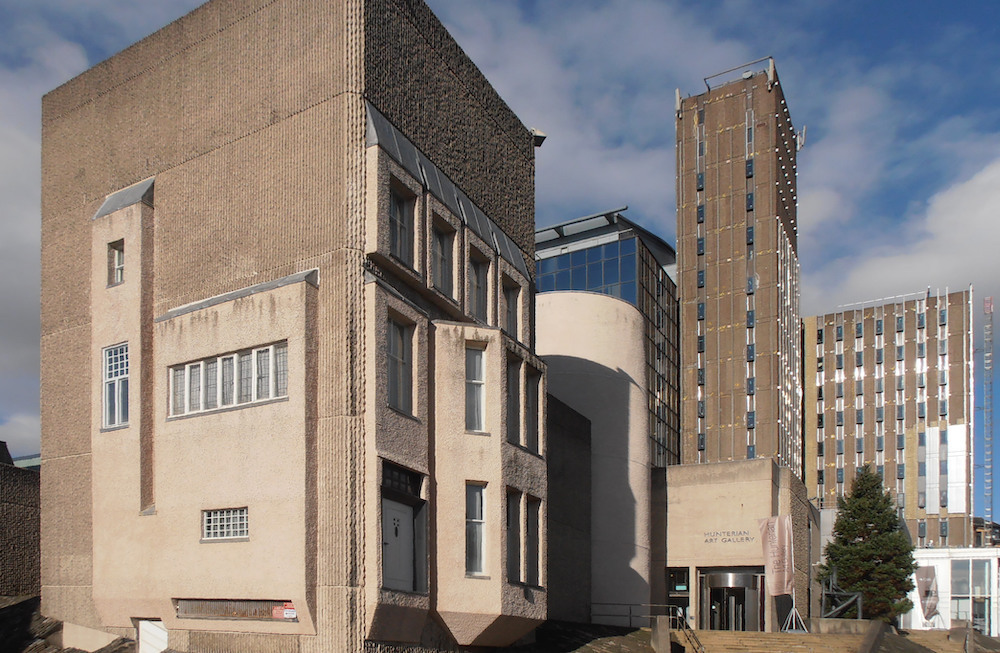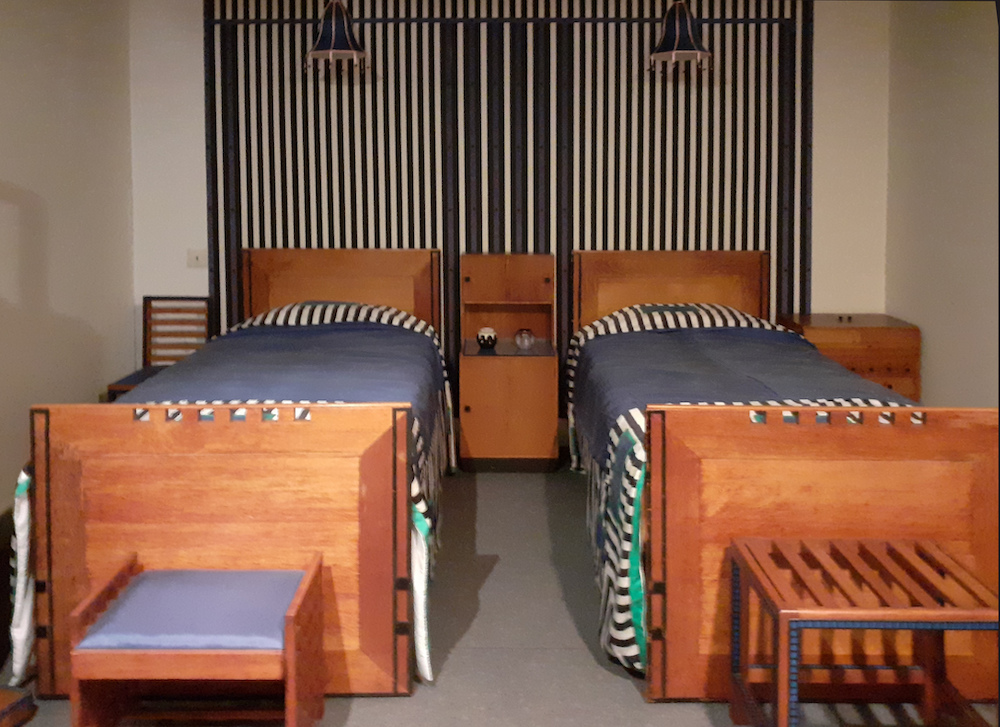This review was originally published on the H-Museum website in 2008. Note that the displays may differ now. The first photograph, of The Mackintosh House with the Art Gallery behind it, is by "Ham II" and available for reuse on the Attribution-ShareAlike 3.0 Unported (CC BY-SA 3.0) licence; the perspective has been corrected. The remaining photographs, and their captions, are by Simon Cooke. Click on them for more information about them. Formatting by Jacqueline Banerjee.

Glasgow University is among the few universities in Europe to have a Museum (Hunterian Museum) and an Art Gallery (Hunterian Art Gallery), both named after Dr. William Hunter (1718-1783), who bequeathed his vast collections to the University, enabling it to open the first museum in Scotland, in 1807. In Glasgow, the great name in science is Lord Kelvin, of "absolute zero" fame (1824-1907) and in the arts it is Charles Rennie Mackintosh (1868-1928). The former has a special display devoted to him in the Museum, while the latter has given his name to a special, built-in section of the Art Gallery, The Mackintosh House, which also has works by his wife, the artist Margaret Macdonald Mackintosh (1864-1933).
The Mackintosh House forms an integral part of the Hunterian Art Gallery, which was built between 1973 and 1981. The exterior is a heavily modified replica of the house at 6 Florentine Terrace [later renamed 78 Southpark Avenue] into which Mackintosh and Macdonald moved in 1906, after the extensive structural alterations which they designed. That house was finally acquired by the University, which had it demolished with the rest of the terrace in 1963 "in what seems to many now, and did to a few then, an act of crass vandalism," as Professor Pamela Robertson, the Senior Curator, puts it in the excellent dedicated Catalogue. One of those few was Professor Andrew McLaren Young, Honorary Keeper of the Art Collections, who made sure that photographs were taken, a measured survey made and as many fitments as possible (fireplaces, skirtings, etc) were stripped out and safely stored before demolition. Thanks to bequests, the University already owned a substantial quantity of original furniture and furnishings designed by the couple.
All that was needed was a permanent home for all these fitments and objects hence the idea of appending a Mackintosh House to the Art Gallery whose construction was envisaged to display the University's fine art collections. The furniture shown was mostly designed and built before 1906, but the curators have made a point of only including exhibits and decorative features and fixtures whose presence at 6 Florentine Terrace is documented.
If the outside does not try to faithfully replicate the original (the terrace had been built in local sandstone, and the House is in concrete covered in "rough cast"), the illusion is complete when one is inside. Even the orientation of the House has been designed to respect the characteristics of 6 Florentine Terrace, which was only about 100 meters away thus giving almost exactly the same views and the same natural lighting. The logic of visiting a "real" house is followed — one starts with the Hall — except that one does not enter through the (retrieved) front door but from what would have been the cloakroom. The most immediately striking elements in this somewhat dark hall are the electric light fittings, which the visitor immediately associates with Mackintosh, or at least Art Nouveau.

The reconstructed Dining Room (1905-6).
Then one enters the Dining Room, whose darkness is hard to believe. The sun was shining outside when I was in it, but the East orientation means that after midday the room does not benefit from its direct light. The most helpful attendant explained that the silver "dew drops" on the walls were meant to reflect the rays of the sun — but this must occur only for a brief period in the morning. The combination of dark-stained oak furniture and grey walls (though with a white frieze and ceiling) does not make the room at all cheerful — an impression reinforced by the high-backed chairs which suggest a sort of "encagement" of the table. These chairs are remarkable for their technique of construction besides the uncanny beauty of their shapes: apparently the design was first used for Miss Cranston's celebrated Tea Rooms. The electric light pendants are again remarkable.
One is relieved to see the light of day again on the first floor, reflected in its full glory on the white walls and predominantly white furniture of the Drawing Room, entering it through a wide window facing South. Mackintosh in fact redesigned the whole structure of this floor, to obtain a large L-shaped open space, with no separation or partition between the Drawing Room and the Studio. The predominant association in the Mackintoshes' time of white with female and black with male is replicated in the colour scheme of the two parts of the "L."

One of Mackintosh’s eccentric chairs — the dark-stained oak and linen-upholstered Lug Chair described below — along with other domestic items such as the lampshades and fireplace, in the Drawing Room.
The "male" Studio has a magnificent (but hardly practical) ebonised mahogany writing cabinet (one of only two made) to which Mackintosh was particularly attached. At a right-angle to it, there is a decorated, predominantly white, bookcase, and facing it above the fireplace, there is a splendid gesso panel by Margaret Macdonald Mackintosh, The White Rose and the Red Rose, which she had designed for the Rose Boudoir exhibited by the couple at Turin in 1902. Other pieces exhibited then are present in the Drawing Room, in front of the South window: a white oval table of medium height (between a dining table and a "coffee" or "low" table), with matching chairs whose high backs (in proportion to the low seating height) are decorated in floral stencil. Several other types of chair are also there to remind the visitor of Mackintosh's extreme creativity in this particular field — tentalisingly he can only evaluate their degree of comfort with his eyes, as it of course forbidden to test them. It must be said that some look extremely uncomfortable for people trained in the Western tradition from their early age, and the "enclosed" upholstered "lug chair" could probably not be used by people of a certain age, because it provides absolutely no purchase to stand up again with the help of one's arms. The Mackintoshes must have only had athletic young guests — they themselves were of course relatively young when they lived at 6 Florentine Terrace.

One of the decorative panels in the Mackintosh House, this one on the door into the Mat Bedroom.
One of the great attractions of the Drawing Room is the cabinet painted white which opens to reveal elaborately decorated doors on their inside face, again standing classical tradition on its head, since in a well-kept home furniture doors are supposed to be closed, whereas on this cabinet it is obvious that they are meant to remain open. The very limited number of objects thoughtfully placed in and on the cabinets and on the mantelpiece complete the re-creation of the atmosphere intended by the Mackintoshes (as attested to by friends and foreign visitors to 6 Florentine Terrace). The make-believe effect is perfect: one forgets that one is in a 1970s building.
Even fewer objects are to be seen in the second-floor Bedroom, almost entirely white and off-white. One part of the "L" which Mackintosh again asked the (re)builders to create is entirely occupied by a four-poster bed with stencilled pale beige curtains, only leaving room on the sides to accede to it. The most remarkable piece of furniture near the windows is the extraordinary "cheval mirror," whose decorative details match those of the large wardrobe on the facing wall. Once more, there is a decorative panel by Margaret Macdonald Mackintosh above the fireplace, this time in silvered beaten brass. All the fireplaces in the house, by the way, were designed by Mackintosh — the most remarkable probably being that of the Drawing Room.


Left: The four-poster bed in the Master bedroom, also showing the fireplace. Right: Twin wardrobes in the Guest Bedroom.
The visit of the "house" proper ends there but there is a further floor, the Mackintosh House Gallery, which displays objects by the Mackintoshes and their friends which do not come from 6 Florentine Terrace (they left it in 1914). The most striking of these exhibits is the reconstruction of a spectacular guest twin bedroom designed and built for a Northampton client in 1917-1919, with the blue striped bedclothes and furnishings contrasting with the golden oak of the beds' head- and foot-boards.


Guest bedroom of 78 Derngate, Northampton, of 1916, in the reconstructed Mackintosh House.
It would be a great pity not to pay a visit to the Mackintosh House on a trip to Glasgow, as it is a fascinating text-book case of the creation of a purpose-built wing integral to a museum in order to house a specific collection in an environment which ideally suits it (in fact in some cases, like the fireplaces, in an environment actually integrating major items in the collection): it is an excellent example of successful museology in complex circumstances.
Note: A Virtual Tour is available on the museum website at the time of writing.
Bibliography
Robertson, Pamela. The Mackintosh House. Glasgow: Hunterian Art Gallery, University of Glasgow, 1998.
Created 26 November 2021
Last modified (images added) 1 April 2023